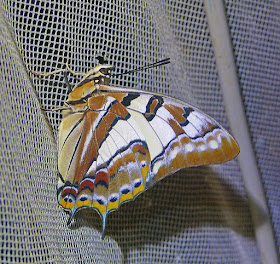Australian Tree
Crickets
Family Gryllidae;
subfamily Oecanthinae
You Ning Su and I are writing a guidebook to Australian
crickets (in the narrow sense). We are gathering photos and information and
have been doing so for the past couple of years. We expect the project to be
completed late in 2017 with publication in the following year. We are happy to receive any photos of
Australian crickets. If they are selected to be in the book, the photographer
will receive a gratis copy of the book in exchange for the use of the
photograph.
The Australian Tree Crickets are known from in two genera, Oecanthus and Xabea. The former is a world-wide genus occurring in tropical and
subtropical regions. Xabea has a much
more limited distribution. It is found mostly in the old World tropics. Both
are nocturnal in their habits.
In Australia, Xabea
is represented by four species all of which are found in north Queensland,
especially along the coast in the rainforest. They are distinctive in colour
and pattern and very different from Oecanthus
in having clasping cerci in both sexes.
We have covered the strange habit of X. atalaia in this blog before. http://bunyipco.blogspot.com.au/search?q=Xabea. Xabea species inhabit the understory
where they live on the undersides of leaves in small populations.
Oecanthus is known
in Australia from three species. Both O.
rufescens and O. angustus are
widespread across most of the country. O.
adyeri has been found only in the Kimberley region of Western Australia.
All occur in grasses, often along the margins of mixed forests. Males produce
loud continuous or broken songs. Several males sing for a while in one place and then move on to
other sites, seemingly as a group.
Concentrated collecting has not produced any additional species of
either genus.
A male X. atalaia Otte and Alexander with his head inserted through a hole in the leaf (the hole not made by him) and the leaf apparently serving as an amplifier. (See the link above)
Head and thorax of a male of X. atalaia. Two of the species of Xabea have very colourful and distinctively marked heads and thoraxes.
Head and thorax of X. leai Chopard
The clasping cerci of a male of X. atalaia.
Female of X. leai.
Male of X.tumbarumba. This species has a greenish tinge.
X. wyebo Otte and Alexander, a rather plain species with a sculptured head and pronotum. See below.
X.wyebo.
Male Oecanthus angustus Chopard. This species usually lacks dark markings on the sides of the tegmina and in the middle of the abdomen. The basal joints of the antennae are unmarked in Australian Oecanthus. This is quite different from the North American species where antennal markings are distinctive of the species.Singing male of O. rufescens Chopard. Note the stripe on the middle of the abdomen.
Male O. rufescens on grass stem at rest. Note median stripe on abdomen and the dark brown stripe laterally of the tegmina (top wings).
Female O. rufescens. Note the brown stripe on the sides of the tegmina.























































